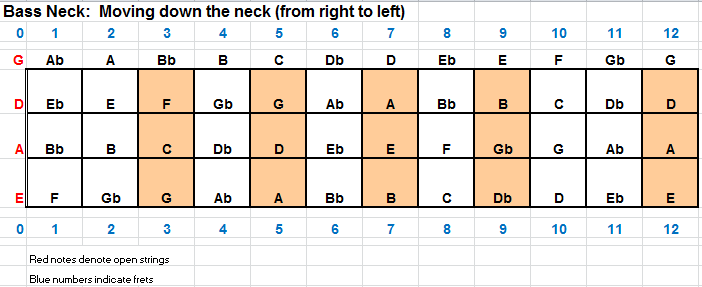Let's take a look at the bass neck. In the diagram below, the red notes depict open strings; the blue numbers depict the frets, and of course, the black notes are what you are playing.
Here's the bass neck showing only the major notes from the nut to the 12th fret:

If you move up the neck from left to right, you call the "in between" notes sharps (#) and if you move down the neck (from right to left), you call the in between notes flats (b).
Here's the bass neck, showing the sharps between major notes.
Let's get oriented. If you are playing a right-handed bass, you play the above notes with your left hand and pick the strings with your right hand. Looking down at your bass neck, the bottom string in the above graphic is actually the top string, the thickest of the four strings. That's the E string (so called because when you play that string "open," without any left hand fingers touching it, the note is E). The string below it is the A string, then the D string and finally, the G string.
Here's the bass neck, showing the flats between major notes.
Moving your left hand fingers up or down the neck will enable you to play the notes pictured above.
Here's where it gets a little confusing. There are two notes that never have a sharped version. They are the notes B and E. When you advance one fret up from B, you do not get B sharp, you get C. When you advance one fret up from E, you do not get E sharp, you get F.
Similarly, there is no C flat (because it is B) and there is no F flat (because it is E). A bit confusing at first, but don't blame me, I didn't invent the system.
Now let's top it off with a useful YouTube video that demonstrates the above information on an actual bass guitar:




9 comments:
i'ts a good lesson but you can put the sharps between major notes in order plis thanks
Anonymous, I do believe I have already done that. Look at all the graphics, not just the top one.
Thanks , I've had a bass for years and always played by ear, this explains the neck very well for me as I don't read music!
Thanks again
Paul
Great Videos and info. I just started learning Bass. Your info is a HUGE help. One question though: I'm picking up quite a bit of good info regarding the fretboard and notes from your charts. I have a chart like your 2nd chart (with the in between notes shown as Sharps), but I WAS TOTALLY UNAWARE that when going down the neck that the "in between notes" are called flats. Why is that??? / why does it change??
I'm also getting a bit confused because I'm a Lefty. Some of the things I see online are obviously "reversed" to me since it's being taught by someone who plays Right Hand.
I'm guessing the notes are in same place on your diagrams for a lefty - correct? (Or would the diagram be changed?) I seriously am confused by that. Logic would tell me that your diagrams / written music in general would be "constant" and just hand position would change between a right hand player / left hand player? Hope that makes sense. A BIG thanks for your video and info.
Anon,I don't think anything changes because you are a lefty, but the charts should be a mirror image for you. Sharps and flats are really the same thing, just depends on which direction you are moving. For example, B flat is also A sharp; G sharp is also A flat. It is just a notation. I generally ignore sharps and think in flats, it's just easier for me that way.
Where it gets confusing is for the notes E and F, B and C. There is no E sharp; one fret up makes it F; likewise, there is no F flat, because that would be E. Same for B and C: There is no B sharp, because it becomes C immediaately; and no C flat, because it become B immediately. Don't worry if it is confusing, it will come with patience and practice.
Thanks!
I'm trying to understand bass more thoroughly and just stumbled upon this page when searching for a diagram of the neck with all the associated notes. Having read through the page I have managed to grasp exactly how it works, so thank you for putting this out there for anyone to access!
Thank u. Very helpful. Rock on!
Just starting to learn bass, so helpful, amazing! Makes things much easier and the best place to start learning!! Done a great job here!!
Post a Comment